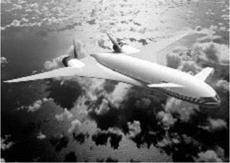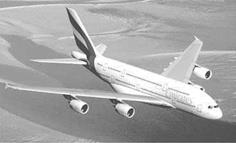Current Civil Aircraft Design Trends
Current commercial transport aircraft in the 100- to 300-passenger classes all have a single slender fuselage, backward-swept low-mounted wings, two underslung wing – mounted engines, and a conventional empennage (i. e., a horizontal tail and a vertical tail); this conservative approach is revealed in the similarity of configuration. The similarity in larger aircraft is the two additional engines; there have been three – engine designs but they were rendered redundant by variant engine sizes that cover the in-between sizes and extended twin operations (ETOPS).
|

Boeing tried to break the pattern with a “Sonic Cruiser” (Figure 1.7) that proved, at best, to be a premature concept. Boeing returned with the Boeing 787 Dreamliner (Figure 1.8) as a replacement for its successful Boeing 767 and 777 series, aiming at competitive economic performance; however, the configuration remains conventional.
The last three decades witnessed a 5 to 6% average annual growth in air travel, exceeding 2 x 109 revenue passenger miles (rpms) per year. Publications by the International Civil Aviation Organization (ICAO), National Business Aviation Association (NBAA), and other journals provide overviews of civil aviation economics and management. The potential market for commercial aircraft sales is on the order of billions of dollars per year. However, the demand for air travel is cyclical and – given that it takes about 4 years from the introduction of a new aircraft design to market – operators must be cautious in their approach to new acquisitions: They do not want new aircraft to join their fleet during a downturn in the air-travel market. Needless to say, market analysis is important in planning new purchases. Chapter 2 briefly addresses market studies.

Deregulation of airfares has made airlines compete more fiercely in their quest for survival. The growth of budget airlines compared to the decline of established airlines is another challenge for operators. However, the reputation of an aircraft manufacturer significantly influences aircraft sales. When Boeing introduced its 737 twinjet aircraft (derived from the three-engine B727, the best seller at the time), the dominant-selling two-engine commercial transport aircraft were the Douglas DC-9 and BAe 111.1 was employed at Boeing then and remember the efforts by engineers to improve the aircraft. The Boeing 737 series, spanning nearly four decades of production to this day, has become the best seller in the history of the commercial – aircraft market. Of course, in that time, considerable technological advancements
|

 have been incorporated, improving the B737’s 50%.
have been incorporated, improving the B737’s 50%.
The largest commercial jet transport aircraft, the Airbus 380 (Figure 1.9) made its first flight on April 27, 2005, and is currently in service. The heretofore unchallenged and successful Boeing 747, the largest commercial transport aircraft in operation today, now has a competitor.
The gas turbine turboprop offers better fuel economy than to current turbofan engines. However, because of propeller limitations, the turboprop-powered aircraft’s cruise speed is limited to about two thirds of the high-speed subsonic turbofan-powered aircraft. For lower operational ranges (e. g., less than 1,000 nautical miles [nm], the difference in sortie time would be on the order of less than a half hour, yet there is an approximate 20% saving in fuel cost. If a long-range time delay can be tolerated (e. g., for cargo or military heavy-lift logistics), then large turboprop aircraft operating over longer ranges become meaningful. Figure 1.10 shows an Antanov A70 turboprop aircraft.











